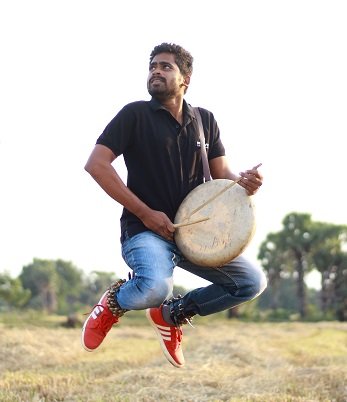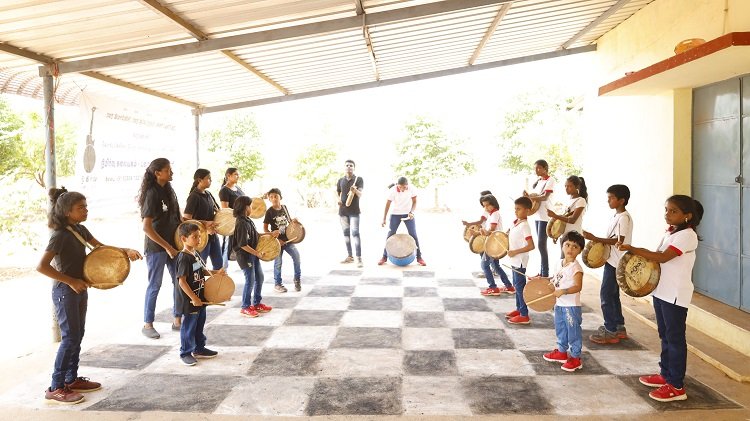Read in : தமிழ்
Parai, an ancient percussion instrument, was once popular in the social and cultural life of Tamil Nadu. But over the years the instrument lost its importance and faded into oblivion, played only by a few communities. However, Mutamil Bharathy, a native of Karaikudi, has been trying to revive the Parai since 2018 by training students on how to play the ancient drum. He has trained more than 500 students so far.
But beyond reviving an ancient tradition, Bharathy, who works as a business process lead, sees playing the Parai as a stress-buster and motivational therapy.
With Bharathy, one can learn the basic lessons in 15 days. You don’t need to buy a Parai, if you can’t afford it. You can borrow one from him. But if you are serious, you need to buy your own drum, which costs Rs 1,600. Played with two sticks, one being larger and thinner than the other, the Parai today is mainly performed in dances, funerals, temple festivals and sporting events.
Though Bharathy was keen on pursuing his B-Tech (biotechnology) and MBA, he gave equal importance to learning Parai, a percussion instrument that he was fond of as a child. He did a one-year diploma course in “Paraiyattakalai ” at the Bharathiar University, Coimbatore. It was while practising on a Sunday morning outside his home in Karaikudi that the idea of training students struck him. To begin with, he started giving training to children in the neighbourhood, and the idea clicked. Soon students from the nearby villages also started joining the group.
Mutamil Bharathy, a native of Karaikudi, has been trying to revive the Parai since 2018 by training students on how to play the ancient drum. He has trained more than 500 students so far
“The children liked the Parai a lot. Even though many have heard the beating of the Parai, it was the first time they got a chance to play one. Since the instrument was not a complex one, they liked it and showed interest in learning. This made my job easier,” recalled Bharathy.
Also Read:
Karagam, Kummi, Mayilattam…the next generation is picking up folk arts from this teacher
Teach children ethics, not attitude, poet and artist Indiran says
There are three types of Parai. The size of the drum varies depending on the age of the player. For children, the ideal size is nine inches while women normally use a bigger one of 11.5 inches. The biggest one that men use is 12 inches. Bharathy sources his instruments from Dindigul. Each drum, made from cowhide, takes three to four days to make. “There are some traditional Parai-makers in Dindigul. I get Parai only from them,” said Bharathy.

Mutamil Bharathy, a native of Karaikudi, has been trying to revive the Parai since 2018 by training students on how to play the ancient drum.
The techie believes that the beats of the Parai help increase a person’s concentration. “With simple rhythmic patterns and movements, the beats of the Parai help one increase the level of concentration, particularly among students. Many of my students told me that they were able to concentrate on their studies better after they started playing the Parai. It also gives a sense of discipline and order,” he said.
Drums similar to Parai, according to Bharathy, are found in the tribal and aboriginal communities all over the world. “We can see such drums used by the indigenous people of Australia, America and many parts of the world. Our ancient Tamil grammar text Tolkappiyam talks about how ancient people used the Parai to communicate and guard their agricultural land. Sangam literature also mentions Parai in detail. It shows how important the instrument is,” said the 28-year-old.
There are three types of Parai. The size of the drum varies depending on the age of the player. For children, the ideal size is nine inches while women normally use a bigger one of 11.5 inches
Bharathy said he had to conduct online classes during the pandemic-imposed lockdown because there were more youngsters who wanted to learn the basics. “I recently went to a school and conducted a two-day training workshop for students on how to play Parai. It was surprising that many picked up the rhythm very fast,” he said.
Stating that he intends to continue training more students, Bharathy said, “I am trying my level best to restore the importance of the instrument that it once had. But at the same time, I use it as an instrument to create harmony and peace in society. I want more people to come forward and understand the importance of Parai,” he added.
Read in : தமிழ்
